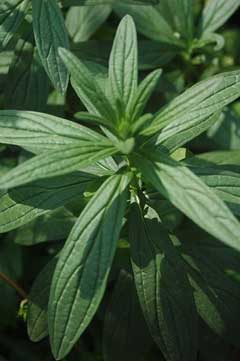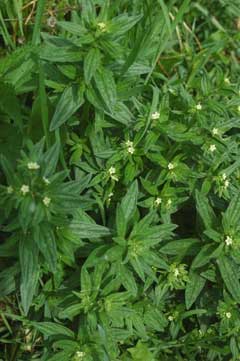 |
|
http://commons.wikimedia.org/wiki/User:Doronenko |
 |
| http://commons.wikimedia.org/wiki/User:Doronenko |
Translate this page:
Summary
Physical Characteristics

 Lithospermum erythrorhizon is a PERENNIAL growing to 0.7 m (2ft 4in) by 0.3 m (1ft).
Lithospermum erythrorhizon is a PERENNIAL growing to 0.7 m (2ft 4in) by 0.3 m (1ft).
See above for USDA hardiness. It is hardy to UK zone 6. It is in flower from June to September, and the seeds ripen from July to September. The species is hermaphrodite (has both male and female organs).
Suitable for: light (sandy), medium (loamy) and heavy (clay) soils. Suitable pH: mildly acid, neutral and basic (mildly alkaline) soils. It can grow in semi-shade (light woodland) or no shade. It prefers moist soil.
UK Hardiness Map
US Hardiness Map
Synonyms
Plant Habitats
Woodland Garden Sunny Edge;
Edible Uses
References More on Edible Uses
Medicinal Uses
Plants For A Future can not take any responsibility for any adverse effects from the use of plants. Always seek advice from a professional before using a plant medicinally.
Antitumor Contraceptive Depurative Eczema Febrifuge Salve
All parts of the plant are antitumor, cardiotonic, contraceptive, depurative and febrifuge[147, 174, 176, 218, 238]. It is used internally in the treatment of irritant skin conditions, measles, chicken pox, boils, carbuncles, hepatitis and skin cancer[238]. Externally it is used to treat nappy rash, burns, cuts, wounds, abscesses, eczema and haemorrhoids[147, 174, 176, 218, 238]. The plant is an ingredient of commercial skin care creams[238]. The plants are harvested when in flower, the roots in the autumn[238]. They are dried for later use[238].
References More on Medicinal Uses
The Bookshop: Edible Plant Books
Our Latest books on Perennial Plants For Food Forests and Permaculture Gardens in paperback or digital formats.

Edible Tropical Plants
Food Forest Plants for Hotter Conditions: 250+ Plants For Tropical Food Forests & Permaculture Gardens.
More

Edible Temperate Plants
Plants for Your Food Forest: 500 Plants for Temperate Food Forests & Permaculture Gardens.
More

More Books
PFAF have eight books available in paperback and digital formats. Browse the shop for more information.
Shop Now
Other Uses
Dye
A purple dye is obtained from the root[46, 61, 218]. It is harvested in the spring[178]. It is much liked but the colour is fugitive and production costs high[174].
Special Uses
References More on Other Uses
Cultivation details
Requires a warm sunny position in a moderately fertile well-drained soil[1, 200]. Prefers a neutral to alkaline soil and also succeeds in partial shade[238]. Plants are hardy to at least -15°c[238]. This species is cultivated in Japan[46] (as a dye plant?).
References Carbon Farming Information and Carbon Sequestration Information
Temperature Converter
Type a value in the Celsius field to convert the value to Fahrenheit:
Fahrenheit:
The PFAF Bookshop
Plants For A Future have a number of books available in paperback and digital form. Book titles include Edible Plants, Edible Perennials, Edible Trees,Edible Shrubs, Woodland Gardening, and Temperate Food Forest Plants. Our new book is Food Forest Plants For Hotter Conditions (Tropical and Sub-Tropical).
Shop Now
Plant Propagation
Seed - sow spring or autumn in a cold frame. When they are large enough to handle, prick the seedlings out into individual pots and grow them on in the greenhouse for their first winter. Plant them out into their permanent positions in late spring or early summer, after the last expected frosts. Cuttings. Division in the autumn[238].
Other Names
If available other names are mentioned here
Native Range
TEMPERATE ASIA: Russian Federation (Kurile Islands, Sakhalin), China (Gansu Sheng (southeast), Guangxi Zhuangzu Zizhiqu (north), Guizhou Sheng, Hebei Sheng, Henan Sheng, Hubei Sheng, Hunan Sheng, Jiangxi Sheng, Liaoning Sheng, Shaanxi Sheng, Shandong Sheng, Shanxi Sheng, Sichuan Sheng), Korea, Japan (Hokkaidô, Honshu, Kyushu, Shikoku)
Weed Potential
Right plant wrong place. We are currently updating this section.
Please note that a plant may be invasive in one area but may not in your area so it's worth checking.
Conservation Status
IUCN Red List of Threatened Plants Status :

Growth: S = slow M = medium F = fast. Soil: L = light (sandy) M = medium H = heavy (clay). pH: A = acid N = neutral B = basic (alkaline). Shade: F = full shade S = semi-shade N = no shade. Moisture: D = dry M = Moist We = wet Wa = water.
Now available:
Food Forest Plants for Mediterranean Conditions
350+ Perennial Plants For Mediterranean and Drier Food Forests and Permaculture Gardens.
[Paperback and eBook]
This is the third in Plants For A Future's series of plant guides for food forests tailored to
specific climate zones. Following volumes on temperate and tropical ecosystems, this book focuses
on species suited to Mediterranean conditions—regions with hot, dry summers and cool, wet winters,
often facing the added challenge of climate change.
Read More
Expert comment
Author
Siebold.&Zucc.
Botanical References
58266
Links / References
For a list of references used on this page please go here
Readers comment
| Add a comment |
|
If you have important information about this plant that may help other users please add a comment or link below. Only comments or links that are felt to be directly relevant to a plant will be included. If you think a comment/link or information contained on this page is inaccurate or misleading we would welcome your feedback at [email protected]. If you have questions about a plant please use the Forum on this website as we do not have the resources to answer questions ourselves.
* Please note: the comments by website users are not necessarily those held by PFAF and may give misleading or inaccurate information.
To leave a comment please Register or login here All comments need to be approved so will not appear immediately.
|
Subject : Lithospermum erythrorhizon
|
|
|
|